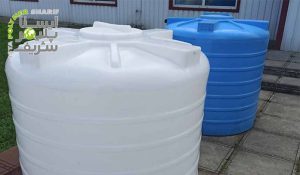If water storage tanks are not cleaned at the appropriate time and in the proper manner, it can lead to contamination of the stored water. Therefore, periodic cleaning of water storage tanks is essential and important. This article from Iranian ABtank will guide you on how to clean a water tank. A water tank for drinking water must be insulated against heat and prevent sunlight from penetrating the tank. It should be seamless and have a smooth, polished interior surface. These features prevent the growth of bacteria, algae in the water, and sedimentation. Exposure to light or heat can lead to algae growth, which is undesirable. However, over time, sedimentation can occur, which decreases water quality. As a result, regular cleaning of tanks is necessary.
Cleaning Polyethylene Water Tanks
Water storage tanks are primarily made of polyethylene. Polymers do not pose a toxicity risk. Due to the high molecular weight and long chains, materials like water do not react with a polyethylene tank. If any contamination enters this water tank, it causes the growth of microorganisms and contaminates the water. If untreated and mineral-rich water enters the tank, it leads to bacterial growth, which should be prevented. Polyethylene tanks are suitable for water storage due to their health department certification and relevant standards. A polyethylene water tank should be cleaned at least once a year if the water hardness is not high and the quality is relatively acceptable. However, if the hardness is high, cleaning should be done more than once a year.
Steps for Cleaning Water Storage Tanks
Cleaning domestic water storage tanks, which are primarily made of polyethylene, is not very difficult. It is important to note that if access to the inside of the tank is not possible, the cleaning method will be significantly different from when inside access is available. When you can access the inside of the tank, cleaning it is easier. If access to the inside is not possible, a home pressure washer should be used.
According to World Health Organization guidelines, the cleaning of water tanks should follow these steps:
- First, the water inside the tank should be drained. Domestic tanks have a drain valve which makes the cleaning process easier.
- The interior surface of the tank should be cleaned with brushes and sponges soaked in cleaning agents to remove sediment with the brush.
- To remove any residual cleaning agent from the previous step, the tank should be refilled with water. Let it stand for a few hours, then drain and rinse the tank with high-pressure water.
- For disinfection, chlorine-based chemicals should be used.
In this method, fill one-quarter of the tank with water. Then add a concentrated chlorine solution, such as powdered calcium hypochlorite with a concentration of 50 to 70 percent. After a few hours, the tank should be drained. Refill the tank with clean water to remove any remaining chlorine. At this stage, use a chlorine meter to measure the chlorine level inside the tank. If the concentration is less than 0.5 milligrams per liter, the tank is completely clean. However, if the concentration is higher, the cleaning process should continue.






